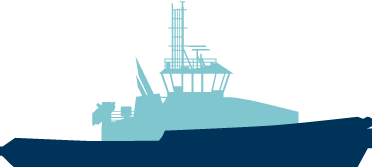2018 has been an exciting year for Østensjø Rederi. Like other offshore companies, we are operating in a difficult market and expect to see similar conditions in 2019. However, Østensjø Rederi has performed well. We have a solid contract backlog and have achieved almost 90 % utilization of the fleet.
By CEO Kenneth Walland
TOWAGE
– In the towage segment, our niche is mainly operations on oil- and gas terminals, escorting and towage, as well as the emergency response function in case of oil spills. This is a specialised market and the growth potential is limited. The fleet we have is on long-term contracts. And the company has recently been awarded another 5-year firm + 2×2 years options to deliver towage- and terminal services at the Shell Nyhamna terminal. Given the fleet we have, the market looks ok, but we do not hide the fact that we would like to see further growth in the years to come.
We continuously monitor the opportunities that open up in this market. This part of the fleet made decent profits last year and it looks good going forward.

OFFSHORE
– The offshore segment is our biggest challenge. The market has been down for a few years, and although Østensjø Rederi has recovered from the downturn and is far better positioned than other offshore companies, there is no doubt that we have been through a demanding period. As for the future market, we assume it will be equally demanding in 2019. However, we have taken steps that have resulted in us doing well. There are signs of more activity, but for our part, we will not notice much improvement yet. From 2020 onwards, there are several signs that rates and activities may pick up. As oil prices are stabilising on a higher level, oil companies are taking their previous development plans out of their drawers and launching projects. – There is a certain delay before these projects will result in more work for us, but from 2020 we have reason to be more optimistic.
We know that the demand for oil will increase and there may be a gap between demand and the overall production. Oil companies have to spend more money and find more oil. What we have done is to take the right measures to ensure we are ready when it happens.

RENEWABLE
– In the case of offshore wind, this market is divided into two. Our two new-buildings are on long-term contracts for Ørsted. We know that the need for such vessels will increase in the coming years. Some analysts have indicated there is a need for up to fifty specialised vessels worldwide over the next decade. These are contracts in a market with much competition and hence tough pricing, but nevertheless, this is a very exciting market for Østensjø Rederi. Within the segment, there are also other needs that must be met when new fields are to be expanded. In those cases, we can also utilise existing newbuilds. These are shorter contracts, but an exciting market for us in the years to come, and not only in the North Sea or Europe. However, Europe will be our main market. It will also be very interesting to monitor this market combined with improvements in the oil & gas market.

FINANCE
Østensjø Rederi is well positioned but is still facing challenges ahead
By CFO Håvard Framnes
Since the drop in the oil price in 2014, the financial situation for Østensjø Rederi has been challenging. However, despite the challenging market conditions, the Østensjø Group achieved a small profit in the 2017 accounts. The main reason being the contributions from Edda Accommodation and Edda Fides. Also, the towage segment was profitable, while the offshore segment is still losing money. For 2018 it is not expected that the Østensjø Group will generate a profit. Edda Fides has been without a contract for most of the past year and the offshore segment is still suffering from low rates.On the other side, the towage segment is doing very well and has become the most profitable part of the group. Also, Edda Passat and Edda Mistral are doing well.
During the last couple of years, the legal structure of the Østensjø Group has been reorganized. This has enabled the group to refinance the fleet at acceptable terms. Combined with a sustainable debt level and a satisfactory cash position, this makes the Østensjø Group financially relatively well positioned. However, in order for the group to overcome the challenges ahead, it will be important to continue the restrictions on expenses and investments.
